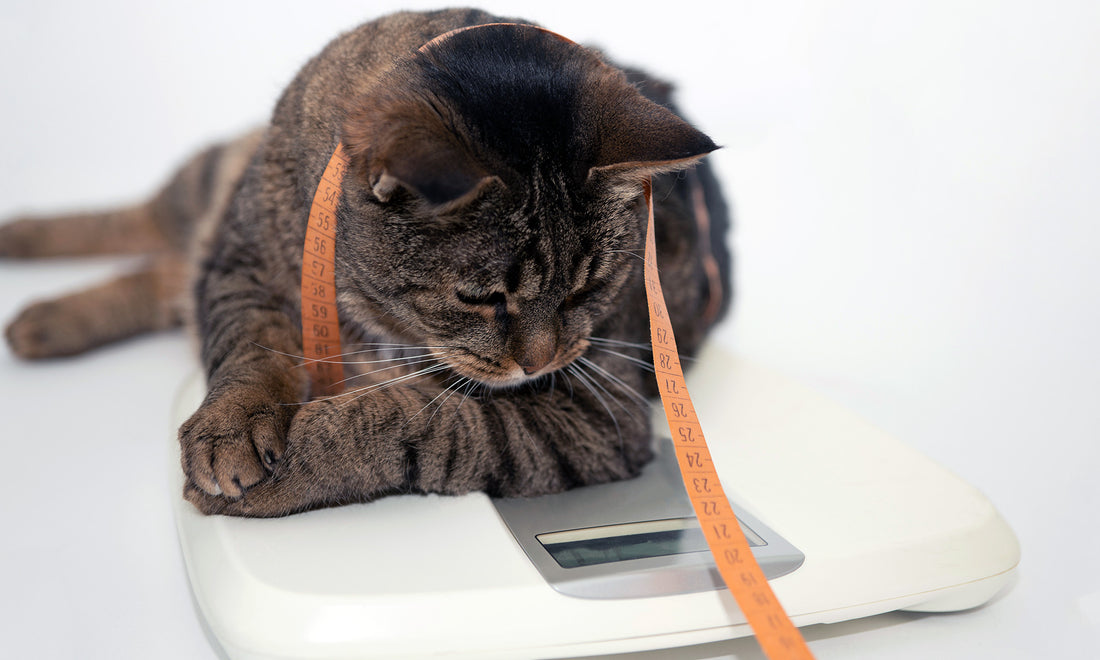
Packing on the Pounds: The Feline 5 Obesity and Weight Gain in Cats
My cat is overweight – what should I do?
Feline obesity is on the rise with shockingly over 50% of cats being overweight. Fewer calories in and more calories out creates a recipe for weight loss success. Simple enough, right? If only it were that easy! Weight loss is difficult for both humans and felines alike. However, shedding those extra pounds can make a world of difference for your cat’s health and longevity. Excessive body fat can put your cat at risk for developing diseases such as osteoarthritis, diabetes, and heart disease. Let’s take a look at the many factors contributing to your cat’s physique.
Feeding Habits
In comparison to their wild counterparts, domestic cats do not need to roam and hunt for their meals. Instead, we provide their meals for them and more than likely we are free feeding. Why? Because it’s easiest for our busy lifestyles. We leave food in a bowl and we give our cats the choice to feed at their leisure. However, this form of feeding encourages overeating which in turn leads to weight gain.
Lack of exercise
Indoor cats lead a predominately sedentary lifestyle, choosing to spend most of their day sleeping than burning calories.
Spay/Neuter status
Pet’s that have been sterilized have fewer caloric needs than those that are intact as a result of slower metabolism. Once spayed or neutered, it is important to adjust your pet’s calories to reflect their reproductive status.
Age
As we age our bodies tend to slow down. Older cats are prone to weight gain due to leading less active lifestyles. Additionally, they may be suffering from arthritis which leaves them with less energy to expend on mobility. Therefore, mature cats require fewer calories than their younger and growing counterparts. The first step in your cat’s weight loss journey is to schedule a consultation with your veterinarian. Your vet will perform a physical exam and other diagnostic testing (such as lab work) to ensure your fur baby’s overall health. During this visit they will also assign your cat a body condition score and use this to determine their ideal body weight. Body condition scores are based off of a nine point scale. A score of 5 indicates ideal body condition. While scores above 5 indicate that your cat is overweight and scores above 8 indicating that your cat is obese. As a veterinarian, one of my favorite weight loss tools is thePet Nutrition Alliance. Their calorie calculator provides nutritional assessments and gives feeding recommendations to help your pet reach their ideal weight. Their assessment will provide an estimated number of calories to feed per day based on your cat’s current body condition score. However, it is important to note that the amount of food that is necessary to provide the suggested number of calories will depend on the calorie content of the food. It is also important to ask your veterinarian which food is appropriate for your pet that meets their individual nutrition needs. Knowing where to begin to help your cat lose weight can be overwhelming. Lets make a commitment to your cat’s health and lets jump start their weight loss journey by following my advice below:
Starvation is not the answer
Portion control is crucial but severely limiting your cat’s food can be dangerous. It can result in a life threatening condition called hepatic lipidosis or fatty liver. Instead, weight loss should occur gradually, aiming to lose 2 % of body weight per week.
Eliminate free feeding
Cats who free feed often over indulge at meal times and tend to graze throughout the day. Therefore, we must eliminate free feeding. Choose specific meal times and allow your pet a limited amount of time to eat the food provided to them. Automatic feeders can be a great resource, allowing you to designate feeding times and feeding amounts. There are even high tech options with microchip readers that only allow specific cats to feed. In this way you can ensure that every cat’s feeding regime is tailored to them.
Working on their fitness
Excessive calorie intake is only half of the problem. Exercise is also an important part of weight loss. However, getting a cat to expend energy is easier said than done. I love incorporating interactive toys to encourage our kitty’s to play. You can try using feather toys, laser pointers and cat-nip infused toys to get your cat on the move. Another pearl is to move their food bowl at different meals to coerce your cat to walk for his meals.
Weigh ins
Lastly, you should regularly schedule weight ins with your veterinarian to ensure that you are staying on track. Accountability leads to success. And regular weigh-ins allow for adjustments to your cat’s individually tailored weight loss plan to be made if needed. The secret to your cat’s weight loss is commitment and a team effort between your family and your veterinarian. Together, you can help your cat live a longer and healthier life. To read more about your cats’ health and tips for making sure they are healthy and strong, read more in the Skoon blogs.










